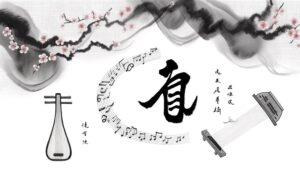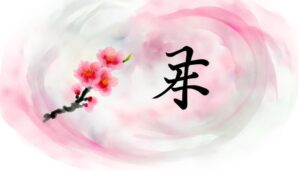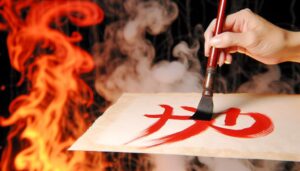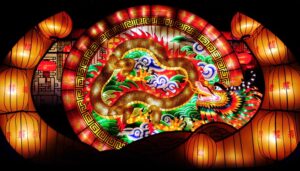How Does the Chinese Dragon Symbol Appear?
The Chinese dragon, represented by the character 龙 (lóng), is a symbol steeped in ancient mythology and cultural significance. It embodies power, strength, and good fortune, reflecting the harmonious balance of yin and yang.
Historically, the dragon was revered by totemic tribes and later associated with imperial authority and masculinity. In art and folklore, dragons control natural phenomena, emphasizing their role in agricultural prosperity and weather control.
The dragon is also central to cultural celebrations like the Dragon Boat Festival and holds a significant place in the Chinese zodiac, denoting ambition and charisma. Discover more about its multifaceted cultural impact.
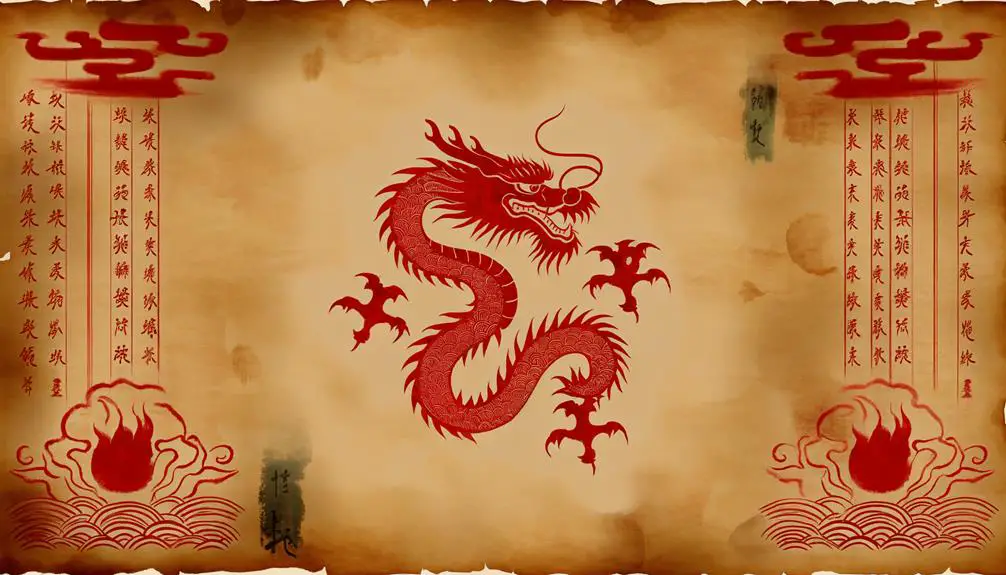
Key Takeaways
- The Chinese character for dragon is 龙 (Lóng).
- The dragon symbol in Chinese culture signifies power, strength, and good fortune.
- The symbol 龙 (Lóng) is deeply embedded in idiomatic expressions and phrases.
- The dragon character represents imperial authority and auspiciousness in Chinese language.
- It embodies a dynamic and vigorous spirit in Chinese cultural heritage.
Origins of the Chinese Dragon
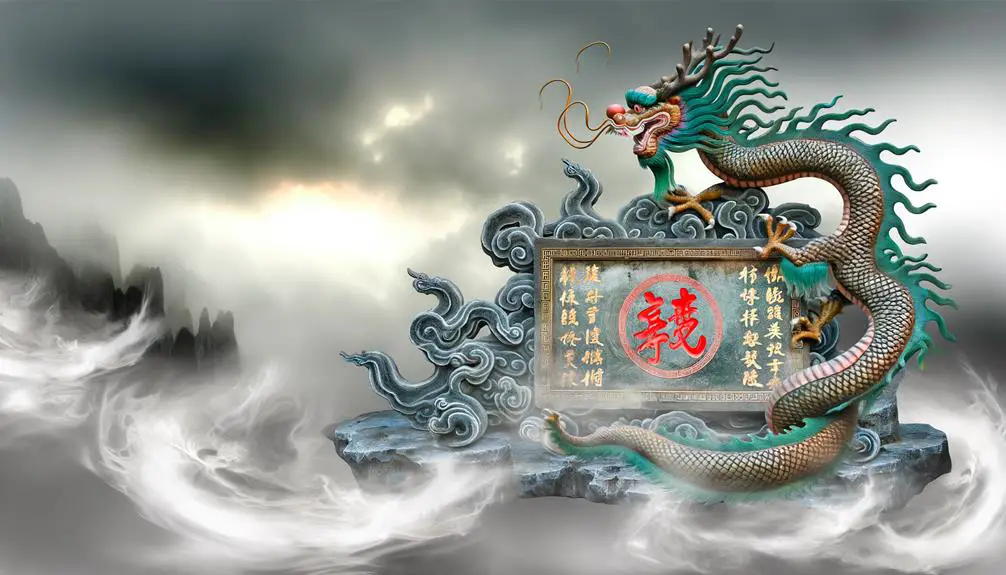
The origins of the Chinese dragon, a symbol of power, strength, and good fortune, are deeply rooted in ancient Chinese mythology and cosmology. This emblematic creature is believed to have evolved from totemic tribes that revered various animals, amalgamating their features into a singular, mythical being.
Archaeological findings, such as jade dragon artifacts from the Hongshan culture (circa 4700–2900 BCE), reveal the dragon's antiquity. The dragon's serpentine form, adorned with attributes of other animals, reflects a synthesis of natural elements and cosmological principles such as water and weather.
In the context of Chinese cosmology, the dragon's presence signifies the harmonious balance of yin and yang, embodying the celestial and earthly domains. This intrinsic symbolism underscores its enduring cultural significance.
Mythology and Legends
In Chinese mythology and legends, dragons are depicted as omnipotent and benevolent beings that wield control over natural phenomena, such as rain, rivers, seas, and the seasonal cycles. These dragons are deeply embedded in the cultural fabric, often symbolizing prosperity, strength, and protection. They are frequently featured in ancient texts and folklore, where their actions and attributes reflect societal values and beliefs.
Markedly, the dragons' influence is categorized into three main aspects:
- Weather Control: Dragons are believed to summon rain and control the weather, ensuring agricultural bounty.
- Water Bodies: They are guardians of rivers, lakes, and seas, maintaining ecological balance.
- Seasonal Cycles: Dragons are integral to the changing seasons, symbolizing renewal and continuity.
This portrayal underscores their revered status in Chinese culture.
Symbolism and Meanings

Exploring the symbolism and meanings of the Chinese dragon reveals a complex tapestry of cultural values and philosophical beliefs deeply ingrained in Chinese society. Historically, the dragon (龙, lóng) symbolizes power, strength, and good fortune. It is often associated with imperial authority, as emperors were considered the embodiment of the dragon.
Additionally, the dragon represents the natural world, particularly water, through its dominion over rain and rivers, signifying agricultural prosperity. In the domain of yin and yang, the dragon embodies yang, symbolizing masculinity and cruciality. Moreover, the dragon's mythical attributes embody wisdom and benevolence, reflecting Confucian ideals.
This multifaceted symbol continues to permeate various aspects of Chinese life, from folklore to modern-day cultural practices.
Dragon in Chinese Art
The dragon occupies a pivotal role in Chinese art, symbolizing power, strength, and auspiciousness, transcending mere decorative function to embody profound cultural significance.
Traditional depictions often present the dragon in dynamic forms, intertwined with natural elements like clouds and water, reflecting its mythical association with control over weather and water bodies.
This artistic representation, richly detailed and imbued with symbolism, underscores the dragon's revered status within Chinese cultural heritage.
Cultural Significance in Art
Dragons in Chinese art serve as powerful symbols of imperial authority, spiritual strength, and auspicious fortune, deeply woven into the cultural fabric and artistic traditions of China. Their representation transcends mere mythological creatures to embody:
- Imperial Authority: Often depicted on the robes of emperors, dragons signify the divine right to rule.
- Spiritual Strength: As intermediaries between heaven and earth, dragons symbolize cosmic balance and supernatural power.
- Auspicious Fortune: Believed to bring prosperity, dragons are frequently featured in New Year celebrations and temple decorations.
This triadic symbolism underscores the dragon's pervasive influence across various artistic mediums, including paintings, sculptures, and ceramics. The multifaceted representation of dragons hence highlights their integral role in shaping Chinese cultural identity and heritage.
Traditional Dragon Depictions
Traditional depictions of dragons in Chinese art are characterized by their sinuous, serpentine forms and intricate detailing, often embodying profound cultural and philosophical symbolism. These majestic creatures are typically illustrated with elongated bodies, whiskers, and clawed limbs, exuding an aura of dynamism and power.
Symbolically, dragons represent auspiciousness, imperial authority, and the harmonious balance of natural forces. In traditional Chinese paintings and sculptures, dragons are frequently portrayed amidst clouds or water, signifying their control over weather and aquatic domains.
The meticulous artistry seen in these depictions reflects the reverence and complexity attributed to dragons within Chinese culture, serving as a tribute to their enduring prominence in mythological and artistic narratives.
Dragon in Festivals
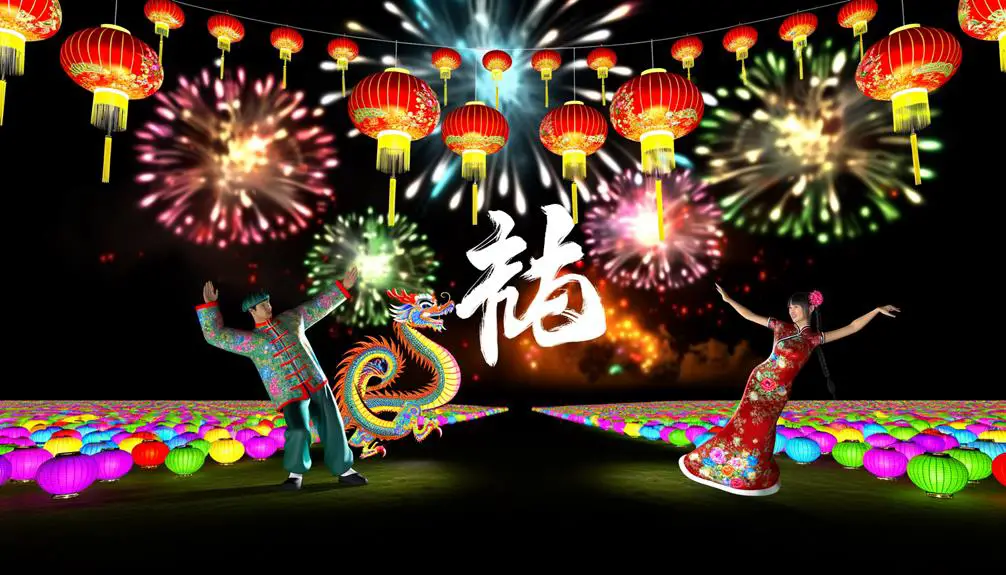
Celebrations such as the Dragon Boat Festival vividly exemplify the cultural significance of dragons in Chinese festivities. This annual event, held on the fifth day of the fifth lunar month, features dragon boat races that reflect the dragon's revered status as a symbol of power and protection. The dragon's prominence in festivals can be analyzed through:
- Symbolism: Dragons symbolize auspiciousness, warding off evil spirits.
- Rituals: Intricate dragon dances performed during celebrations embody cultural heritage and communal spirit.
- Artistry: Elaborate dragon motifs in decorations, costumes, and boats underscore the artistic expression of reverence.
These elements encapsulate the dragon's integral role in Chinese cultural festivals, offering insights into its enduring legacy and multifaceted representation.
Imperial Associations
The dragon has historically been an emblem of imperial power and authority in Chinese culture, often associated with the emperor and the celestial mandate. This mythical creature symbolized the emperor's divine right to rule, embodying strength, wisdom, and prosperity. The dragon motif was prevalent in imperial regalia, architecture, and official documents, reinforcing the ruler's supremacy and divine sanction.
| Aspect | Description |
|---|---|
| Imperial Regalia | Dragons adorned the emperor's robes, emphasizing his celestial status. |
| Architecture | Dragon motifs featured prominently in palaces and temples. |
| Official Seals | Imperial seals often bore dragon imagery, signifying authority. |
| Celestial Mandate | The dragon symbolized the emperor's divine right to govern. |
In essence, the dragon's association with the emperor was a powerful representation of ultimate sovereignty and celestial endorsement.
Dragon in Modern Culture
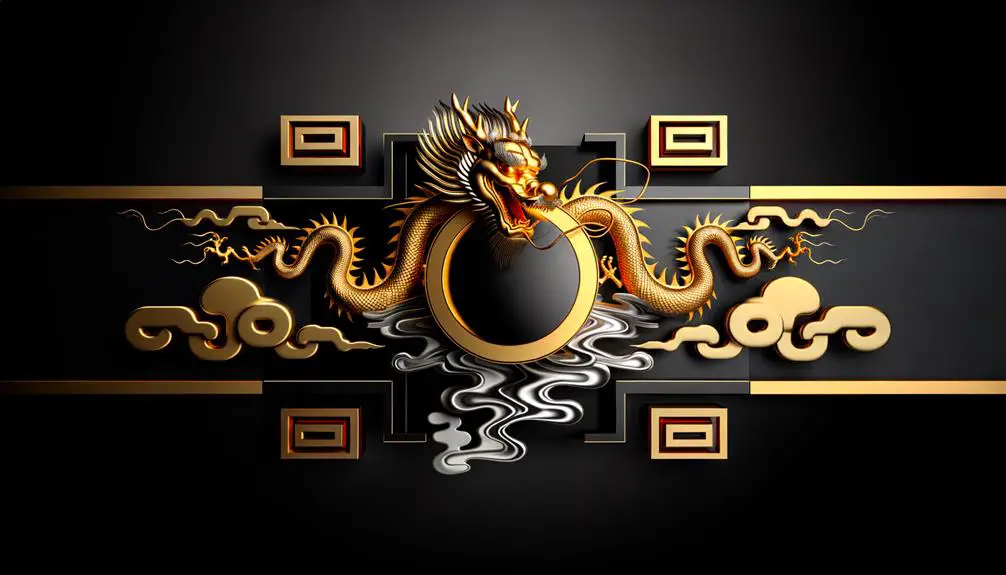
While the dragon's historical ties to imperial power remain a significant aspect of Chinese heritage, its role in modern culture has evolved into a multifaceted symbol representing various elements of contemporary society.
Today, the dragon embodies:
- National Identity: As an emblem of strength and unity, the dragon is often used in patriotic contexts, such as national celebrations and symbols.
- Cultural Festivals: The dragon prominently features in events like the Dragon Boat Festival, reflecting communal harmony and traditional values.
- Pop Culture: Modern media, including films, literature, and video games, frequently depict dragons, contributing to their dynamic and evolving symbolism.
This transformation illustrates the dragon's enduring relevance and adaptability within the diverse landscape of modern Chinese culture.
Regional Variations
Regional variations in the depiction and cultural significance of the dragon across China highlight the diverse interpretations of this emblematic creature.
In northern China, dragons are often portrayed as powerful, fearsome guardians, symbolizing imperial authority and military strength.
Conversely, southern regions, such as Guangdong and Fujian, depict dragons with more serpentine bodies, embodying agricultural prosperity and water-related blessings.
The coastal areas emphasize the dragon's control over seas and weather, reflecting the local dependence on maritime activities.
Ethnic minorities, such as the Miao and Dong, integrate unique dragon motifs into their clothing and rituals, underscoring the dragon's role in ethnic identity and spiritual beliefs.
These regional interpretations collectively underscore the dragon's multifaceted role within Chinese cultural heritage.
Dragon in Chinese Zodiac
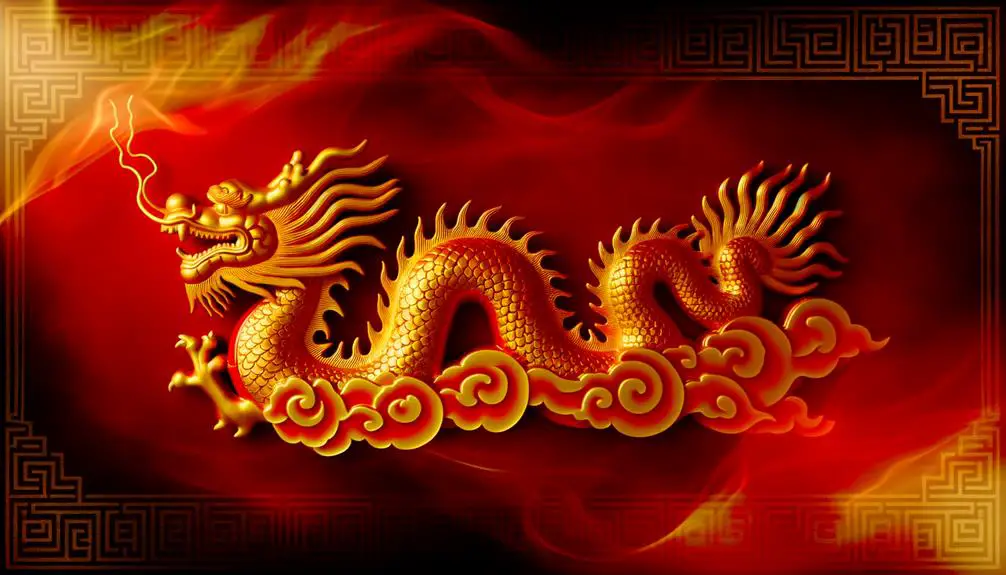
The Dragon, one of the twelve animals in the Chinese zodiac, is often associated with potent personality traits such as ambition, intelligence, and a natural charisma.
These characteristics not only influence the individual born in the Year of the Dragon but also play a vital role in determining zodiac compatibility with other signs.
Dragon Personality Traits
In the Chinese Zodiac, individuals born under the sign of the Dragon are often characterized by their dynamic personalities, marked by traits such as confidence, ambition, and an innate sense of leadership. These traits are ingrained within the cultural symbolism of the Dragon, which epitomizes power, authority, and mystical allure.
Dragons are known for their unwavering determination and entrepreneurial spirit, often excelling in leadership roles. Key traits that define the Dragon's personality include:
- Confidence: Dragons possess an unshakable belief in their abilities.
- Ambition: They are driven to achieve high goals and aspirations.
- Leadership: Their natural charisma enables them to inspire and lead others effectively.
This amalgamation of traits renders Dragons as influential and inspiring figures within various cultural contexts.
Dragon's Zodiac Compatibility
Understanding the Dragon's compatibility with other zodiac signs requires a nuanced examination of how their charismatic and ambitious nature interacts with the inherent traits of each sign within the Chinese Zodiac.
Dragons are often most compatible with the Rat and Monkey, whose intelligence and adaptability harmonize with the Dragon's dynamic energy.
Conversely, they may experience tension with the Dog, as the Dog's loyalty and caution can clash with the Dragon's boldness.
The Dragon finds balance with the Snake, whose wisdom complements their ambition, and with the Rooster, who appreciates their vigor.
Traditional Chinese astrology emphasizes that these interactions are influenced by the Five Elements, adding further depth to the compatibility matrix and enriching cultural understanding.
Dragon Symbol in Language
A profound symbol in Chinese culture, the dragon (龙, lóng) embodies a rich tapestry of meanings and linguistic significance. In the Chinese language, the dragon is not merely a mythical creature but an emblem of power, auspiciousness, and the emperor's divine authority. Linguistically, the character 龙 appears in numerous idiomatic expressions and phrases, reflecting its cultural depth.
- 龙腾虎跃 (lóng téng hǔ yuè): Denotes a dynamic and vigorous spirit.
- 望子成龙 (wàng zǐ chéng lóng): Expresses the hope that one's child will achieve greatness.
- 龙马精神 (lóng mǎ jīng shén): Symbolizes energy and an indomitable will.
These examples illustrate how the dragon permeates various aspects of the Chinese language, enriching its expressive capacity.
Conclusion
The Chinese dragon is an emblem of imperial power and cosmic energy that weaves through the nation's mythology, art, and cultural practices like a celestial tapestry. From its origins in ancient folklore to its portrayal in modern celebrations and the zodiac, this mythical creature encapsulates wisdom, strength, and auspiciousness.
Through intricate brushstrokes in art and the rhythmic dance of festivals, the dragon continues to animate the cultural ethos of China, symbolizing a timeless connection between the heavens and the earth.

